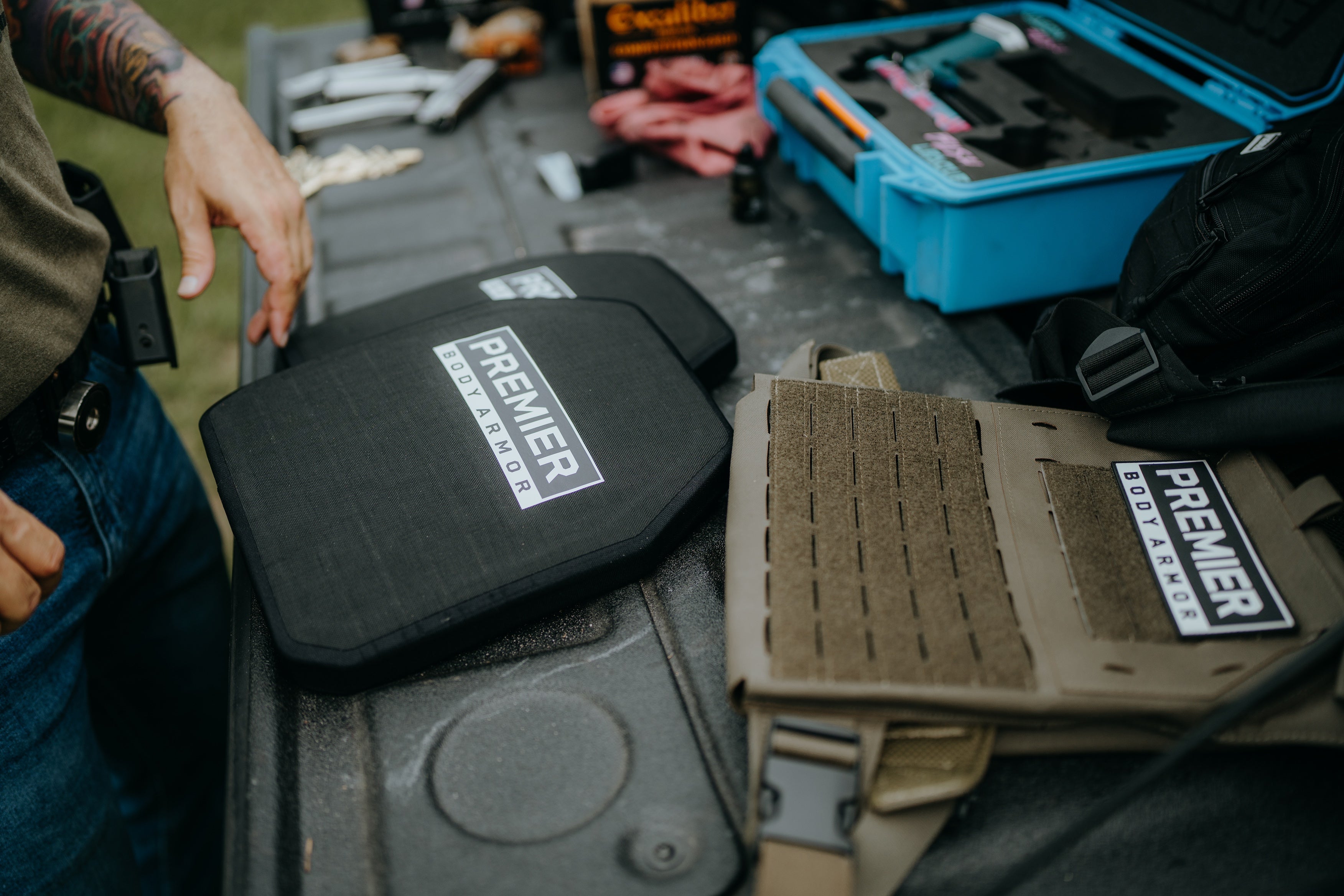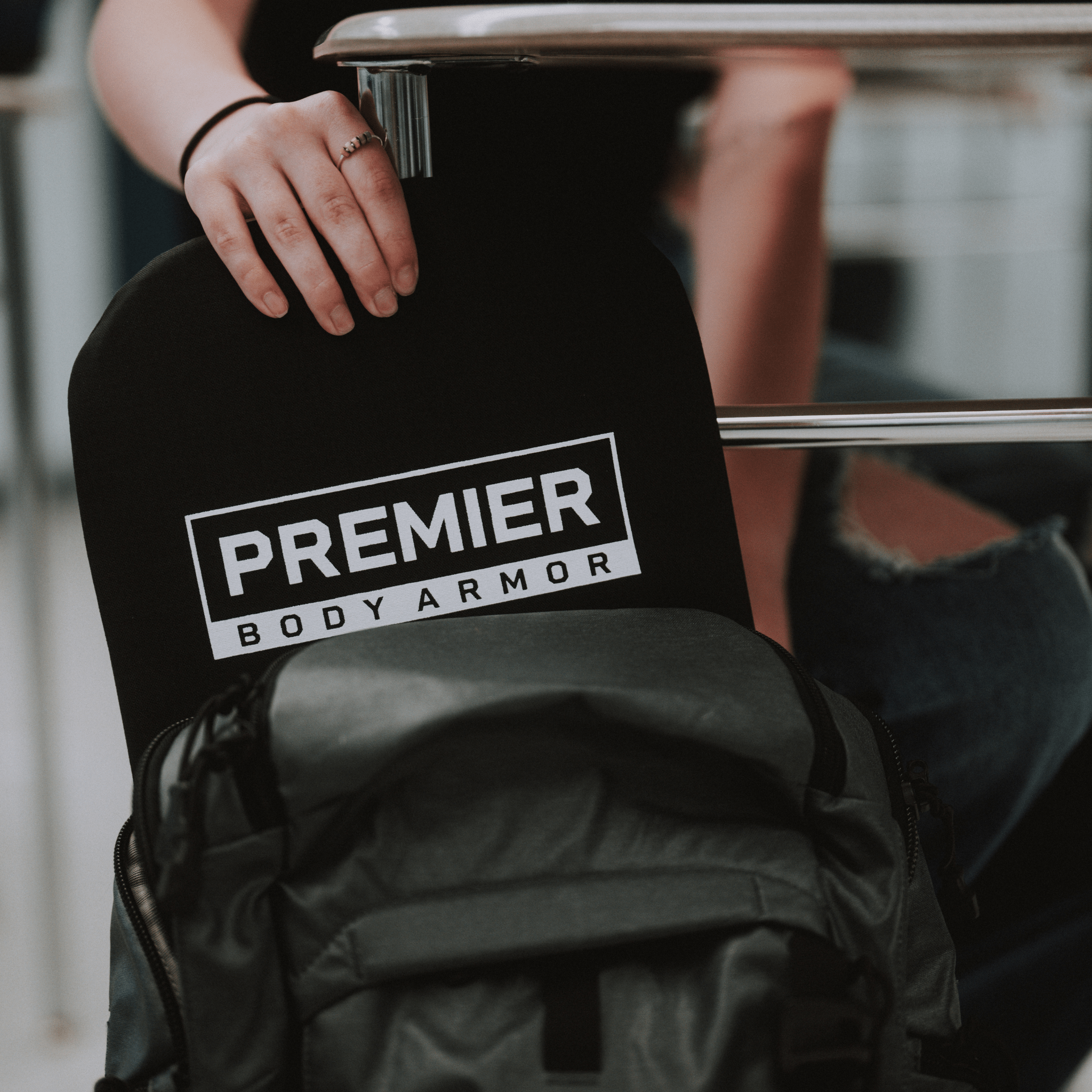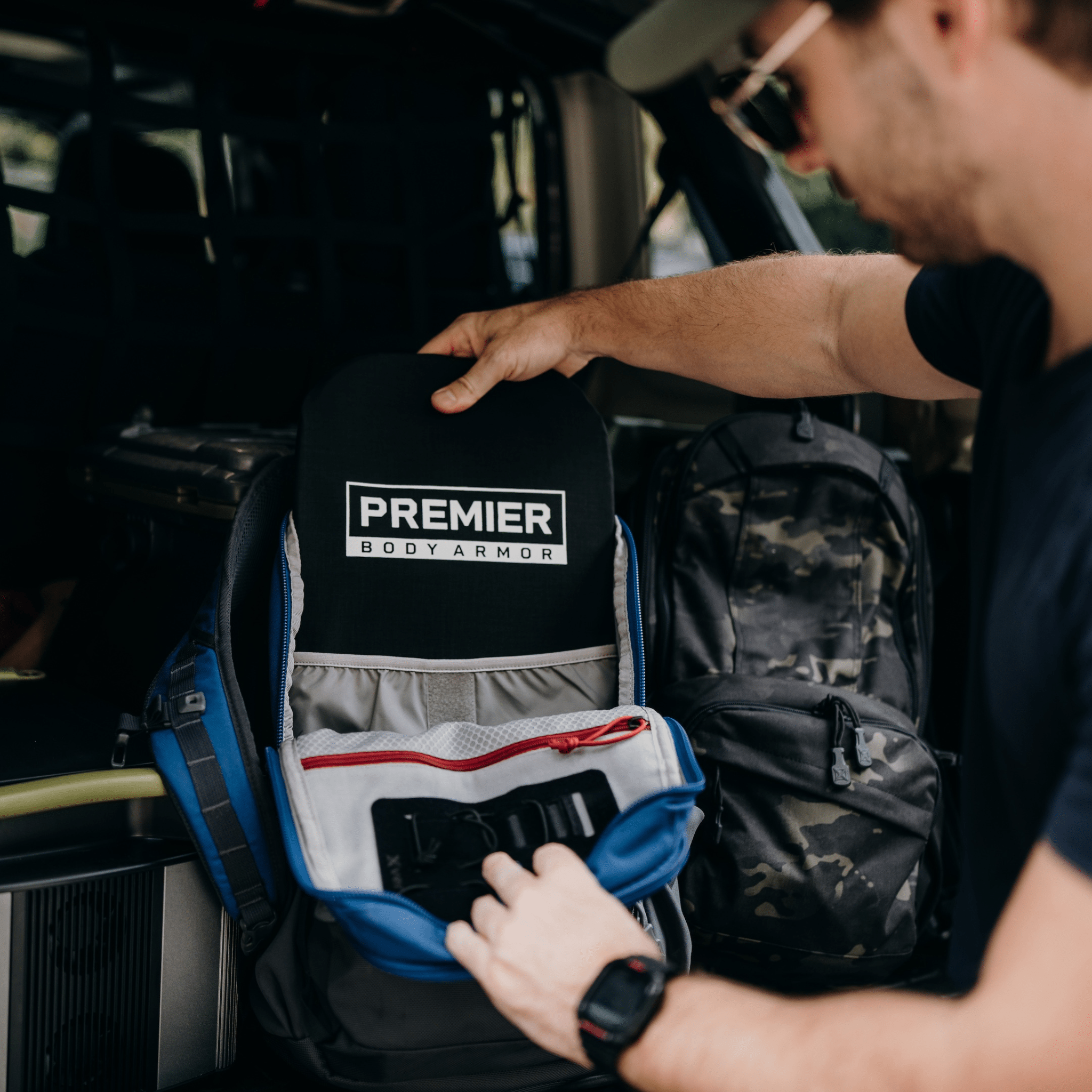Do Bulletproof Backpacks Work?
updated November 2025
Short answer - yes, if matched to the correct armor level. Most backpack armor inserts are rated Level IIIA (or HG2 under the new standards) and designed to stop handgun rounds from 9mm to .44 Magnum.
Higher-rated inserts (Level III/IV) can stop rifle rounds like 7.62 NATO, but these are heavier and more expensive. However, it is important to keep in mind that no armor is truly bulletproof; the correct term is bullet-resistant.
Bulletproof backpacks rated IIIA protect against handgun rounds; higher ratings protect against rifles, but no armor guarantees complete safety.
At-A-Glance
• Level IIIA/HG2 = protection against most common handguns.
• Panels are ~0.22" thin, ~1-2lbs, TSA-approved, and fit in the bag you already carry.
• For rifle threats, choose a backpack rated RF1/Level III. It will be heavier, but protect against higher threats
What is a bulletproof backpack?
A bulletproof backpack refers to any standard bag upgraded with ballistic protection. There are two primary options:
- Backpack Inserts: Removable ballistic panels placed in an existing bag or backpacks.
- All-in-One Backpacks: Built-in armor sewn directly into the bag.
Both methods use materials tested to NIJ ballistic standards, similar to traditional body armor.
Bulletproof backpacks include removable inserts or built-in panels that meet NIJ ballistic standards for handgun protection.

How To Make A Bulletproof Backpacks
Bulletproof backpack inserts and built-in panels are made by layering tightly woven para-aramid fibers in a crisscross pattern. Multiple sheets are stacked, compressed, and sewn together into a flexible, thin panel. These finished panels are either sewn into backpacks or sold as removable inserts.
For durability, Premier Body Armor panels are sealed in ripstop to waterproof the panel. The panels are then wrapped in Cordura® to create a sturdy, waterproof, and durable insert.

Reinforcing a backpack with body armor is a great way to increase the ballistic protection of a bag or backpack.
How Do Bullet Proof Backpacks Work?
Bulletproof backpacks work by absorbing a bullet's energy using multiple layers of aramid fibers. On impact, these tightly woven fibers stretch and disperse energy, trapping the bullet and preventing penetration.
This process limits dangerous back-face deformation, helping prevent severe injury. High-quality backpack panels can withstand multiple handgun hits before material failure. Our backpack armor has been tested to withstand multiple hits.
Are Bulletproof Backpacks Effective in Real-Life?
The effectiveness of bulletproof backpacks depends on bullet type, velocity, angle of impact, and armor construction. NIJ Level IIIA backpacks effectively protect against handgun rounds, the most common firearms in school shootings.

Since 1982, 81% of school shootings have been carried out with a handgun as the primary weapon, which means in an active school shooter situation, the perpetrator is more likely than not to be wielding a handgun.
However, most soft armor backpack inserts cannot reliably stop rifle rounds without heavier, higher-level armor (Level III or IV). While beneficial, backpacks should complement, not replace, other safety measures.
What is the Threat-Protection of Backpack Armor?
The level of threat protection offered by backpack armor largely depends on the type and grade of ballistic materials used in its construction. Most are tested to Level 3A on the National Institute of Justice (NIJ) scale. This means they are rated to stop bullets from most common handguns and gauge shotguns.
However, backpacks with this level of protection may not stop bullets from rifles or semi-automatic weapons, which require Level 3 or 4 armor. Some manufacturers offer backpacks or backpack inserts with these higher levels of protection, but they are often heavier and more expensive.

You can learn more about the NIJ's body armor levels in our Understanding Body Armor Ratings article.
Is Bulletproof Backpack Armor NIJ Certified? NIJ Certification vs NIJ Testing
The NIJ certifies complete armor systems (front/back panels of a body armor vest), and will not certify standalone backpack panels. Reputable manufacturers have independent labs test backpack inserts according to NIJ standards. When looking for a bulletproof backpack or ballistic shield for a backpack, look for wording like "Tested to NIJ Level IIIA" instead of "NIJ Certified."
At Premier Body Armor, our backpack inserts are made using the same ballistic material and process as our body armor vests that ARE NIJ Certified and law enforcement quality.
Key Features of Bulletproof Backpacks
- Armor plates or para-aramid, like Kevlar®, panels for ballistic protection
- Reinforced stitching to ensure panel durability
- Snag-resistant zippers and sleek design to maintain mobility during emergencies

How much do bulletproof backpacks cost?
Pre-built bulletproof backpacks typically range from $100 to $400, depending on armor rating and quality. Bulletproof backpack inserts alone cost approximately $75 to $250+, influenced by size, armor level, and materials used.
Benefits of Bulletproof Backpacks
- Provides rear torso protection when worn normally
- Can quickly be moved to front as an emergency ballistic shield
- Offers discreet, effortless daily protection, requiring no extra steps to carry
How to Use a Bulletproof Backpack
- Try to escape and get to safety - It's always best to observe your environment and have a plan so you can move quickly if necessary.
- Turn your backpack around and cover your head and chest with your bag if the threat is in front of you. You can use the straps to carry the backpack in front of you, or slide your arm through the straps and use the bag as a shield.
- Cover your vital organs. The most important thing is keeping your cardiac box, where vital organs like your heart, lungs, etc. are, protected by the armor.

It's important to talk with your child about using their backpack as a shield so they are better prepared. Teach children simple steps: identify threat direction, move backpack accordingly, and protect the chest and head area.
Do I need a bulletproof backpack?
If you find yourself struggling to choose whether or not you would benefit from owning a bulletproof backpack, consider potential situations where one might be useful. If you travel, work in an urban area, visit a grocery store or mall, go to the movie theatre, or visit the range, body armor is for you.

Another potential use case is bulletproof backpacks for students. As active shooter situations have occurred more in schools, it is worth investing in the safety of a child or student in case of emergency. At just 1 pound, Premier Body Armor backpack inserts add little weight and are extremely discreet.

Who Should Consider a Bulletproof Backpack?
- Frequent travelers and daily urban commuters
- Anyone visiting crowded venues such as malls, theaters, or concerts
- Parents focused on added safety for children at school
Bulletproof Backpack vs. Backpack Insert
There are two products on the market for backpack armor - the “bulletproof backpack” and the “bulletproof backpack insert/panel”. It's important to note that while these may sound similar, they are different products.
| Feature | Bulletproof Backpack (Built-In Panel) | Bulletproof Insert / Panel |
|---|---|---|
| Armor Placement | Ballistic panel sewn permanently into lining | Removable panel slides into backpack compartment |
| Weight | Can be heavy (especially with steel plates) | Lightweight (≈1–2 lb Level IIIA) |
| Flexibility | One-bag solution; limited customization | Move panel to any new pack you buy |
| Replacement | Must replace whole backpack | Swap in a new panel every ≈5 years |
| Cost Efficiency | Higher upfront cost per bag | Lower cost to upgrade multiple bags |

The advantage of the bulletproof panel is the ability to choose the backpack. If you get a new backpack, you can simply switch your panel to the new bag.
Where to buy bulletproof backpacks
If you are looking to purchase a bulletproof backpack, there are various online retailers where you can find them. However, it is important to exercise caution and ensure that the backpack you choose is compliant with relevant standards.
When buying online, it is recommended to research reputable retailers and manufacturers that offer NIJ-certified or tested products. Reading customer reviews can also provide insights into the quality and performance of different products.
However, be aware that purchasing online may carry some risks, including the potential for counterfeit or non-compliant products. It is important to thoroughly research and verify the authenticity and compliance of the insert before making a purchase.
Are Bulletproof Backpacks Legal?
Body armor, including bulletproof backpacks or panels, are legal to own and use in many countries, including the United States (with the exception of convicted felons). Regulations can differ by state or locality, so confirm local laws before purchase or use.

Premier Body Armor's Backpack Panels
Premier Body Armor sells bulletproof backpack panels in a variety of sizes and colors. We produce bullet-resistant panels because we believe body armor should fit your lifestyle. You can use a regular backpack - the color and style you like - and simply add our panel in the back.
Premier Body Armor Backpack Panel Specifications:
- NIJ Level IIIA tested ballistic protection
- TSA compliant for air travel
- Ultra-thin profile (0.22 inches)
- Lightweight (1-2 pounds)
- Resistant to limited stab and slash threats
- 100% made in the USA
*Note on stab proof inserts: Ballistic fibers naturally resist cuts, but ballistic backpack inserts are not tested or rated to NIJ 0115 (stab standard). For dedicated edged-weapon protection, use armor built specifically for NIJ 0115.
Ready to experience top-notch safety? Check out our collection of backpack armor.
FAQs for Bulletproof Backpacks
Can a Bulletproof Backpack Stop an AR-15?
The ability of a bulletproof backpack to stop an AR-15 or any high-powered rifle round depends on the specific level of protection it offers. AR-15 rifles typically require higher-level armor, such as Level III or IV. Review the product specifications and ballistic rating of any body armor to ensure it offers the protection you are looking for.
Can I Bring a Bulletproof Backpack on a Plane?
Yes, body armor is an approved TSA item. We recommend placing your ballistic protection in either checked or carry-on bags, as both are permissible under TSA guidelines. The final decision rests with the TSA officer at the checkpoint, but our team has never had an issue with a bulletproof panel making it through.
How Much Do Bulletproof Backpacks Weigh?
The weight of bulletproof backpacks can vary depending on factors such as the level of ballistic protection, the size of the insert, and the materials used. Generally, bulletproof backpacks with lower-level protection, such as Level IIIA, tend to be lighter. On average, a Level IIIA bulletproof backpack insert can weigh between 1 to 3 pounds.










Leave a comment